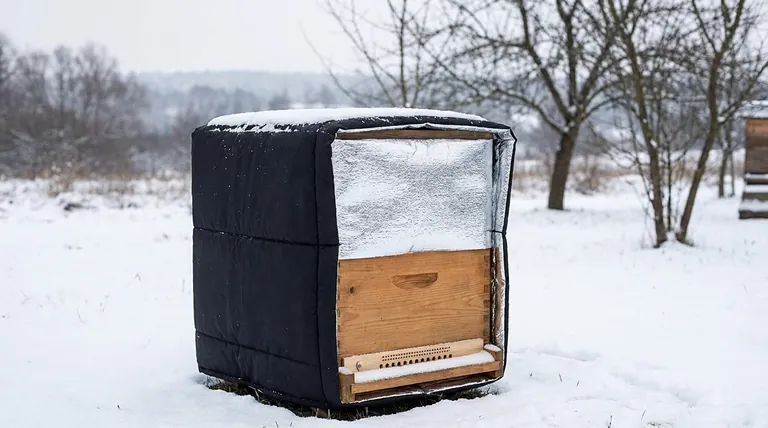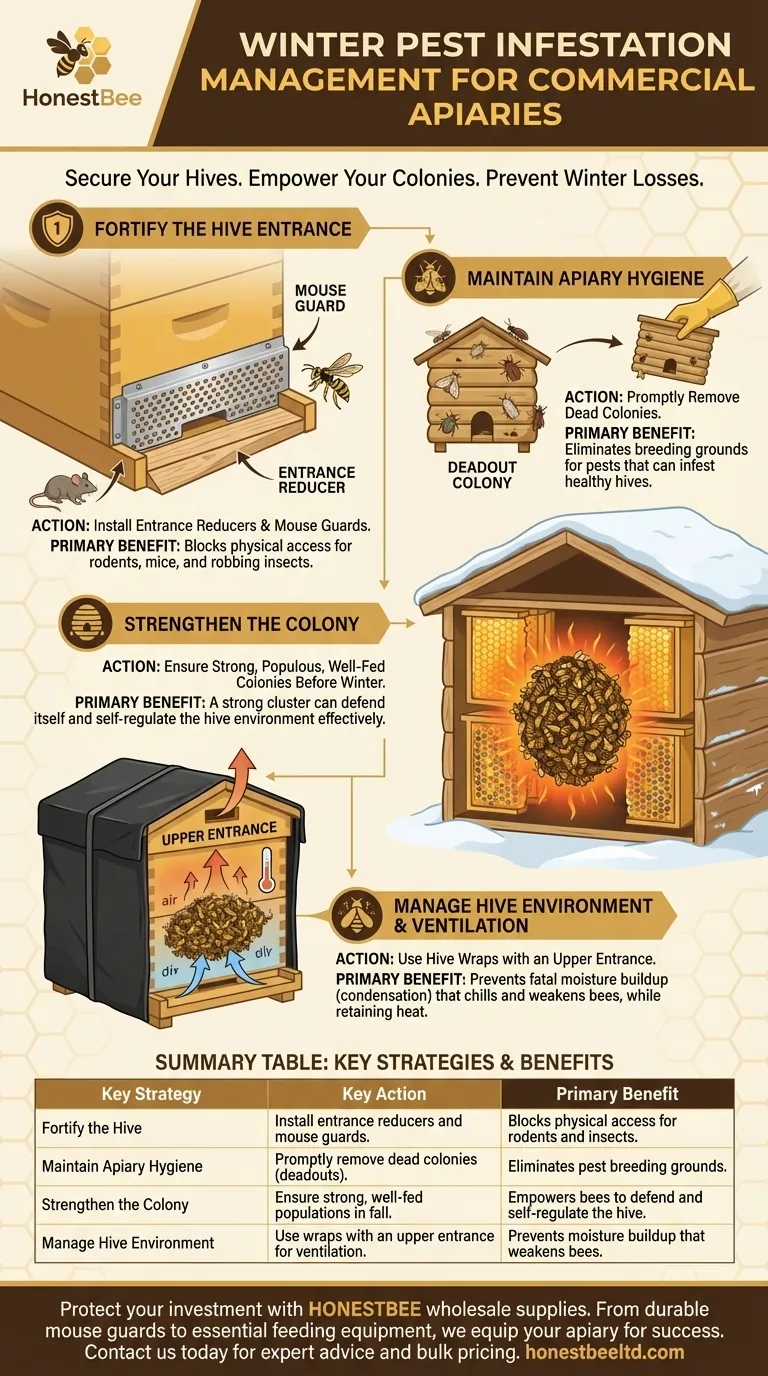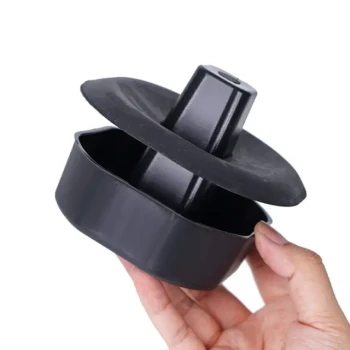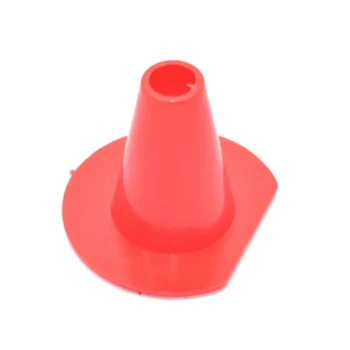To reduce pest infestations in winter, beekeepers must focus on two key strategies: physically securing the hive and ensuring the colony is strong enough to defend itself. This involves installing entrance reducers or mouse guards to block access, promptly removing any dead colonies that attract pests, and maintaining a healthy, well-fed bee population that can effectively manage its own environment.
The core principle of winter pest management is not just about blocking entry points; it's about transforming the hive into a secure, self-regulating fortress. A strong, dry, and well-fed colony is the single most effective deterrent against invaders.

The Winter Hive: A Prime Target for Pests
In the cold, barren landscape of winter, a beehive is an irresistible target. It offers warmth, shelter, and a dense concentration of high-energy food (honey), making it a beacon for opportunistic pests.
Why Pests Invade
Rodents like mice seek a warm nest with a ready food source. Other insects and pests are drawn to abandoned or weakened hives, where they can breed and spread, posing a threat to other healthy colonies in the area.
The Colony's Vulnerability
During winter, the bee colony is in a state of reduced activity. The bees form a tight cluster to generate heat, making them less able to patrol and defend the entire hive cavity, especially the periphery. This defensive lapse is what pests exploit.
Fortifying the Hive Entrance
The most direct line of defense is physically blocking unwanted entry. The hive entrance is the primary gateway for pests and must be secured before the cold sets in.
Installing an Entrance Reducer
An entrance reducer is a simple device that constricts the size of the hive's main entrance. This gives the bees a much smaller, more defensible area to guard against robbing insects and other intruders.
The Critical Role of a Mouse Guard
Mice are a significant threat, capable of destroying a colony by consuming honey stores and bees, and fouling the combs. A mouse guard, a type of entrance reducer with holes large enough for bees but too small for mice, is essential winter equipment.
Eliminating Unwanted Invitations
A clean and well-managed apiary is less attractive to pests. Weak or dead hives are a major liability that can quickly escalate into a larger problem.
The Danger of a "Deadout"
A "deadout" is a hive where the colony has died. Letting a deadout sit is like putting out a welcome mat for pests. Wax moths, hive beetles, and rodents will quickly move in to consume the remaining resources.
Remove Dead Colonies Immediately
It is critical to check your hives during winter and promptly remove any deadout colonies. This prevents them from becoming breeding grounds for pests that can later infest your surviving, healthy hives.
Why a Strong Colony is Your Best Defense
Ultimately, a hive's security comes from within. A populous, healthy, and well-fed colony has the manpower and energy to defend its home and regulate its internal environment effectively.
Build Strength in Summer and Fall
Winter preparation begins long before winter. Your goal should be to ensure colonies are strong, populous, and disease-free throughout the preceding summer and fall. A powerful colony is better equipped to manage threats.
Ensure Adequate Food Stores
A starving colony cannot generate heat or mount a defense. Ensure your bees have a full hive of honey. If necessary, feed them sugar syrup in the fall to supplement their stores after the honey harvest. It's also wise to move honey frames together so the winter cluster doesn't have to cross large, cold gaps to reach food.
Managing the Hive Environment: A Delicate Balance
Properly insulating and wrapping a hive helps the bees conserve energy, but it must be done correctly to avoid creating new problems like moisture buildup, which weakens the colony.
The Goal of Insulation and Wrapping
Wrapping hives, often in black plastic, helps reduce wind exposure and retain solar heat. Additional insulation can also be added to protect bees from extreme cold and drafts, helping them maintain the cluster's temperature more efficiently.
The Critical Need for Ventilation
A completely sealed hive is a death trap. The bees' respiration releases a significant amount of warm, moist air. If this moisture cannot escape, it will condense on cold inner surfaces, drip down on the cluster, and fatally chill the bees.
Provide an Upper Entrance
To combat condensation, hives wrapped for winter must have a small upper entrance hole. This allows moist air to ventilate out, keeping the hive interior dry while still protecting the bees from harsh winds. It also gives the bees a way to exit for cleansing flights on warmer days.
Your Winter Action Plan
Your approach to winter pest management depends on combining physical barriers with holistic colony health practices.
- If your primary focus is direct pest prevention: Immediately install a mouse guard or entrance reducer and be vigilant about removing any deadout hives from your apiary.
- If your primary focus is long-term colony resilience: Concentrate on building strong, disease-free colonies during the summer and fall, and ensure they have more than enough food to last until spring.
- If your primary focus is optimal environmental control: Use hive wraps and insulation to protect from wind and cold, but always ensure there is an upper entrance for proper ventilation to keep the colony dry.
By creating a secure, dry, and well-provisioned home, you give your bees the best possible chance to not only survive winter but to emerge strong and ready for the season ahead.
Summary Table:
| Key Strategy | Key Action | Primary Benefit |
|---|---|---|
| Fortify the Hive | Install entrance reducers and mouse guards. | Blocks physical access for rodents and insects. |
| Maintain Apiary Hygiene | Promptly remove dead colonies (deadouts). | Eliminates pest breeding grounds. |
| Strengthen the Colony | Ensure strong, well-fed populations in fall. | Empowers bees to defend and self-regulate the hive. |
| Manage Hive Environment | Use wraps with an upper entrance for ventilation. | Prevents moisture buildup that weakens bees. |
Protect your investment and ensure your colonies thrive. Winter is a critical time for your apiary's health. HONESTBEE supplies commercial apiaries and beekeeping equipment distributors with the durable, reliable supplies needed for effective winter pest management, from heavy-duty mouse guards to essential feeding equipment. Let our wholesale-focused operations help you secure your hives. Contact HONESTBEE today for expert advice and bulk pricing on the equipment your operation depends on.
Visual Guide

Related Products
- Professional Insulated Winter Hive Wrap for Beekeeping
- Professional Ant-Proof Beehive Stand with Integrated Moat for Beekeeping
- Multi-Functional Sliding Hive Entrance for Beekeeping
- HONESTBEE Professional Long Handled Hive Tool with Precision Cutting Blade
- Boardman Entrance Bee Feeder Durable Galvanized Steel and Wood Construction for Beekeeping
People Also Ask
- What are the steps to properly wrap a beehive for winter? Ensure Your Colony Survives the Cold
- What are the durability features of Bee Blankets? Built to Last in Demanding Apiary Conditions
- Why is it important to insulate beehives during winter? Boost Your Colony's Survival Rate
- Is it always necessary to insulate beehives? A Guide to Winter Survival & Colony Health
- Why is insulation important for hives during winter? Ensure Your Bees Survive and Thrive



















